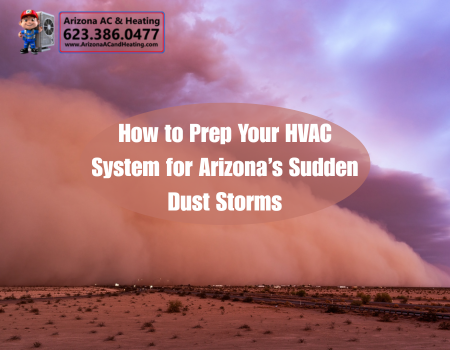Living in Arizona means you’re no stranger to sudden, sweeping dust storms that can turn a clear afternoon into a brown haze in minutes. Known locally as haboobs, these intense walls of dust and debris can pose serious challenges to your home’s HVAC system. The fine dust particles infiltrate your system, clog filters, reduce air quality, and strain your unit — sometimes leading to breakdowns right when you need cool air the most.
Being proactive about preparing your HVAC system for dust storm season can save you from costly repairs and keep your home’s air cleaner and safer. Here’s a detailed guide on how to get your system storm-ready and protect your indoor comfort.
Tips to Prep Your HVAC System for Dust Storms
 1. Inspect and Replace Air Filters Frequently
1. Inspect and Replace Air Filters Frequently
Your HVAC system’s first line of defense against dust is the air filter. During dust storm season, it’s a good idea to check your filters more often than usual — ideally once a month or even biweekly if a major storm blows through. Clogged filters restrict airflow, force your system to work harder, and reduce the overall air quality inside your home.
When replacing, opt for high-efficiency filters (like HEPA or electrostatic options) that are specifically designed to capture fine dust and airborne particles common in Arizona’s desert environment.
2. Seal Gaps and Cracks Around Your Home
Dust storms exploit any opportunity to creep into your home. Check doors, windows, and attic access points for gaps or worn weather stripping. Sealing these areas not only prevents dust from entering your living space but also reduces the load on your HVAC system by keeping cool air inside and hot, dusty air out.
Add door sweeps to exterior doors and use caulking or weatherstripping to seal around windows and vents. Don’t forget less obvious spots like pet doors, attic hatches, and dryer vents.
3. Schedule a Pre-Season HVAC Inspection
It’s a good idea to schedule an HVAC inspection with a professional before dust storm season reaches its peak. A technician can clean internal components, check for wear and tear, and ensure everything is running efficiently. Proactive maintenance like this catches minor problems early, preventing expensive repairs later and making sure your system can handle the added stress from dust and debris.
4. Install or Upgrade to a Programmable Thermostat
A programmable or smart thermostat isn’t just about convenience; it can also help manage your indoor air quality during a dust storm. These devices can be programmed to reduce HVAC use during the height of a storm and resume normal operation once conditions improve. Some smart thermostats even have air quality sensors and can alert you when the air indoors is compromised.
5. Protect Outdoor Units
Your HVAC’s outdoor condenser unit is especially vulnerable during a dust storm. Large amounts of dust, debris, and plant matter can clog the fins and restrict airflow, reducing efficiency or damaging the unit.
Before storm season, clear away any leaves, branches, or debris from around the unit. During a storm, it’s helpful to cover your condenser unit with a breathable, protective cover designed for HVAC systems — but remember to remove it immediately after the storm passes to avoid overheating.
6. Consider Adding an Air Purification System
If you’re particularly sensitive to dust or have allergies, integrating an air purification or air scrubber system into your HVAC setup can make a noticeable difference. These systems work alongside your HVAC unit to filter out airborne pollutants, including fine dust particles that may sneak through even the best filters.
7. Adjust HVAC Use During a Storm
When a dust storm hits, it’s wise to minimize how much outside air your system pulls in. Close windows, doors, and fresh air intake vents (if possible). Running the HVAC system on recirculation mode helps limit the amount of outdoor dust entering your home.
Arizona’s sudden dust storms are unavoidable, but with a little planning and routine care, you can keep your HVAC system protected and your home’s air cleaner. Regular filter changes, sealing entry points, professional inspections, and smart adjustments during storms will not only extend the life of your HVAC unit but also create a safer, healthier indoor environment for you and your family.
Don’t wait until dust storms are barreling toward your home — prep your system now and breathe easier when the storms roll in.
